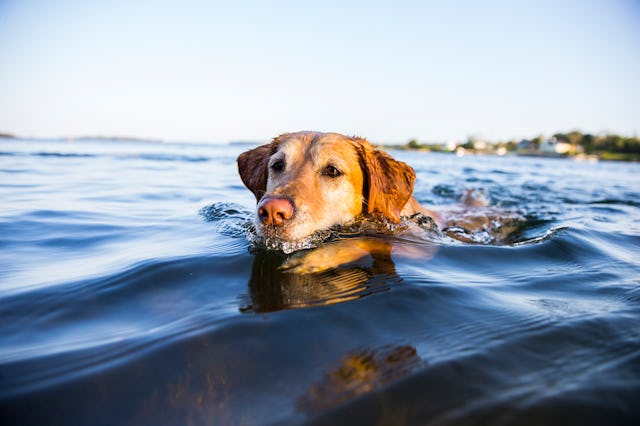Is It Safe To Let My Dog Swim Outdoors This Summer?
Everything vets want you to know before Rover dives in.

I live in Florida, which means lots of beach and boat days on the water. It’s the whole point of living here! And naturally, many families like to bring their furry friends along for the fun. If you’re not accustomed to having your dog around water, though, you may be wondering, Is it safe to let my dog swim at the lake, in the ocean, or in a creek? Even the most experienced pet parents might not know everything they need to in order to keep their beloved pups safe.
So, we asked a few veterinarians about all the different hazards your dog might encounter, and what you, as their owner, should do to keep them safe — and help them have the most fun — while swimming.
Assess your dog’s experience and the kind of water they’ll be diving into.
If your dog is new to swimming, don’t drop anchor in the center of a lake and expect them to hop into the drink. Instead, take them somewhere they can enter gradually until they’re comfortable enough to swim.
“My top two concerns when dogs swim are their experience in the water and the cleanliness of the water itself,” says Merck Animal Health veterinarian Dr. Laura Greene. “Just like with kids, if it’s your dog’s first time swimming, don’t let them jump into deep water — let them enter gradually and get comfortable going in and out. At the ocean, avoid areas with strong waves or currents. And if you wouldn’t swim in the water, your dog probably shouldn’t either, especially stagnant water that can harbor bacteria, protozoa, or harmful algae.”
Check your local advisories for any warnings about dangerous algae blooms before swimming, too. “This is a serious issue, particularly in the summer. Blue-green algae, or cyanobacteria, can produce toxins that can kill dogs. Always check local advisories, and if the water is green, slimy, or has an odd odor, stay away. Bacteria such as Leptospirosis are also found in standing water, so keeping your dog up to date on their shots and rinsing them off after a swim are good preventive measures,” says Dr. Aimee Warner, resident veterinarian at Waggel.
Warner also suggests being mindful of strong currents, submerged objects, rocky drop-offs, and freezing water temperatures that could shock your dog.
Buy your dog a life jacket and get them used to wearing it on land first.
Ideally, your dog’s life jacket will have handles so they’re easy to grab in the water, and it will be brightly colored so they’re always visible. Whether a dog should wear a life jacket depends on their swimming experience and the environment, Greene says.
“In calm, shallow water with easy access, many dogs don’t need one. But if they’re jumping off a boat in deep water or are small breeds, puppies, or brachycephalic dogs — like pugs or bulldogs — a life jacket is a smart safety measure. When in doubt, it’s always better to err on the side of caution and put the jacket on.”
All dogs swimming in moving water with a current or waves should wear a life jacket, regardless of how experienced they are, says Dr. Julie Hunt, veterinarian at Embrace Pet Insurance. That extra bit of flotation will help make swimming less exhausting and help prevent the worst.
Watch for hazards on shore that your dog may not be familiar with.
How many dogs have seen a jellyfish before? Not many, but they wash up on the beach from time to time. Unless you want your pup to bite the very spicy squeaky toy of the sea, you should check out the area you’ll be spending time in before letting your dog roam.
“Environmental hazards such as jellyfish, glass, sharp shells, fish hooks, and litter can injure curious paws or noses. A glance at the terrain before allowing your dog to sniff can prevent cuts or stings,” Warner says.
Give your dog lots of breaks, whether they want to take them or not.
Our canine companions don’t always show outward signs of being tired. Warner says your dog needs a break immediately if they are:
- Swimming erratically
- Struggling to keep their head above water
- Bobbing or trying to float
- Constantly looking to shore
- Trembling, whining, or panting heavily
Many owners don’t realize how tiring swimming can be for a dog, so keep your pet’s fitness level in mind. Hunt says dogs that can hike for hours without stopping can probably swim for 30 minutes without a break, while a couch potato pup should only do five. Even fit dogs new to swimming should rest after 10 to 15 minutes, even if they seem eager to keep at it, Greene says. Overexertion can lead to muscle strains and even drowning, these experts say.
Always supervise your dog when they’re swimming.
You wouldn’t let your kids swim without an adult present, and you shouldn’t let a fur baby do it either, Hunt says. This is true in natural bodies of water and pools at home.
With the right precautions, you and your dog can have so much fun swimming together and enjoying the outdoors. Here’s to a fun summer of safe swimming with family and our four-legged loved ones.